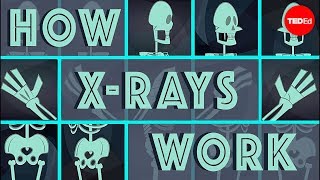(单词翻译:单击)
In 1895, a physicist named Wilhelm Roentgen was doing experiments with a cathode tube,
1895年,有一位叫威廉·伦琴的物理学家,用一个阴极管做实验,
a glass container in which a beam of electrons lights up a fluorescent window.
这是一个玻璃装置,里面有一道电子光束照亮荧光幕。
He had wrapped cardboard around the tube to keep the fluorescent light from escaping, when something peculiar happened.
他用纸板把阴极管包起来,来阻止荧光消散,这时奇特的事情发生了。
Another screen outside the tube was glowing.
阴极管外面的一个屏幕发光了。
In other words, invisible rays had passed through the cardboard.
换句话说,就是一道不可见光穿透纸板投射到外面来了。
Wilhelm had no idea what those rays were, so he called them X-rays, and his discovery eventually won him a Nobel Prize.
威廉不知道这些光束叫什么,于是就管它们叫做X光,而他的这项发现为他赢得了诺贝尔奖。
Here's what we now know was happening.
以下就是他所发现的现象。
When high energy electrons in the cathode tube hit a metal component,
当具有高能量的电子在阴极管内撞击到金属物质时,
they either got slowed down and released extra energy,
它们要么速度降低,释放一些额外能量,
or kicked off electrons from the atoms they hit, which triggered a reshuffling that again released energy.
要么把受到撞击的原子所带的电子敲掉,启动电子组合并继续释放能量。
In both cases, the energy was emitted in the form of X-rays,
在这两种情况下,能量都通过X光的形式释放出来,
which is a type of electromagnetic radiation with higher energy than visible light, and lower energy than Gamma rays.
这也是一种电磁辐射的形式,它的能量高于可见光,低于伽马射线。
X-rays are powerful enough to fly through many kinds of matter as if they are semi-transparent,
X光足可以穿透任何物质,好像任何物质都是半透明的一样,
and they're particularly useful for medical applications
X光的这一特性使得它在医学上应用广泛,
because they can make images of organs, like bones, without harming them,
因为它可以下不伤害器官骨骼的情况下获得器官以及骨骼的图像,
although they do have a small chance of causing mutations in reproductive organs,
尽管有极小的可能它会引起分裂细胞突变,
and tissues like the thyroid, which is why lead aprons are often used to block them.
像甲状腺组织,这也就是为什么人们经常会用铅围裙去阻挡X光。
When X-rays interact with matter, they collide with electrons.
当X光与其他物质发生作用时,它会撞击电子。
Sometimes, the X-ray transfers all of its energy to the matter and gets absorbed.
有时候,X光会将它所有的能量转移到其它物质上并被该物质所吸收。
Other times, it only transfers some of its energy, and the rest is scattered.
而有时,它只转移了一部分能量,剩余的能量则分散开来。
The frequency of these outcomes depends on how many electrons the X-rays are likely to hit.
这些结果的发生频率取决于X光可能撞击到电子的数目。
Collisions are more likely if a material is dense,
物质的结构越紧密,碰撞越可能发生,
or if it's made of elements with higher atomic numbers, which means more electrons.
又或者如果该物质有较高的原子数,即较高电子数,碰撞也越可能发生。
Bones are dense and full of calcium, which has a relatively high atomic number, so they absorb X-rays pretty well.
骨头结构紧密并富有钙质,即原子序数相对较高,所以骨骼就更容易吸X光。
Soft tissue, on the other hand, isn't as dense,
而另一方面,软组织则不是那么紧密,
and contains mostly lower atomic number elements, like carbon, hydrogen, and oxygen.
包含原子序数更低的元素,像碳、氢、氧等。

So more of the X-rays penetrate tissues like lungs and muscles, darkening the film.
所以X光更容易穿透像肺和肌肉等柔软组织,在屏幕显示黑色。
These 2-D pictures are only useful up to a point, though.
但是这些2D影像并不能非常清准确的反射人体的组织。
When X-rays travel through the body, they can interact with many atoms along the path.
当X光穿过人体的时候,它会和它途中遇到的所有电子发生反应。
What is recorded on the film reflects the sum of all those interactions.
因此反映到屏幕上面的影像是所有反应的汇总。
It's like trying to print 100 pages of a novel on a single sheet of paper.
就像是我们将100页纸的内容都打在一页纸上一样。
To see what's really going on,
如果你想要清楚地看清这些组织的结构,
you would have to take X-ray views from many angles around the body and use them to construct an internal image.
你就需要从身体不同角度来照X光,并用这些X光影像来构建出其内部的图像。
And that's something doctors do all the time in a procedure called a CT,
这是医生一直在做的一种叫做CT的诊断,
Computed Tomography scan, another Nobel Prize winning invention. Think of CT like this.
计算机体层扫描,也赢得了诺贝尔奖。我们可以这样理解CT扫描。
With just one X-ray, you might be able to see the density change due to a solid tumor in a patient,
如果只有一道X光线,你可能只能看到因一个病人体内实体瘤而引起的密度变化,
but you wouldn't know how deep it is beneath the surface.
但是你并不能知道这个肿瘤有多深。
However, if you take X-rays from multiple angles, you should be able to find the tumor's position and shape.
但是如果你从各个角度来做X光扫描,你就能看清楚这个肿瘤的位置和形状。
A CT scanner works by sending a fan or cone of X-rays through a patient to an array of detectors.
CT扫描是将一个扇形或锥状的X射线射出,穿透病人之后,由排成阵列的感应器接收。
The X-ray beam is rotated around the patient, and often also moved down the patient's body,
X射线环绕病人旋转,也经常会移动到病人身体下方,
with the X-ray source tracing a spiral trajectory.
X射线光源沿着螺旋轨迹行进。
Spiral CT scans produce data that can be processed into cross sections
螺旋CT扫描产生的数据能被处理成横断面影像,
detailed enough to spot anatomical features, tumors, blood clots, and infections.
精细到可以标记出解剖特点、肿瘤、血块及感染。
CT scans can even detect heart disease and cavities in mummies buried thousands of years ago.
CT扫描甚至可以检测出数千年前埋葬的木乃伊的心脏疾病及蛀牙。
So what began as Roentgen's happy accident has become a medical marvel.
当初伦琴的意外发现如今已变成了一个医学奇迹。
Hospitals and clinics now conduct over 100 millions scans each year worldwide to treat diseases and save lives.
现在,全世界的医院和诊所每年执行超过一亿次的扫描,来治疗疾病及拯救生命。


